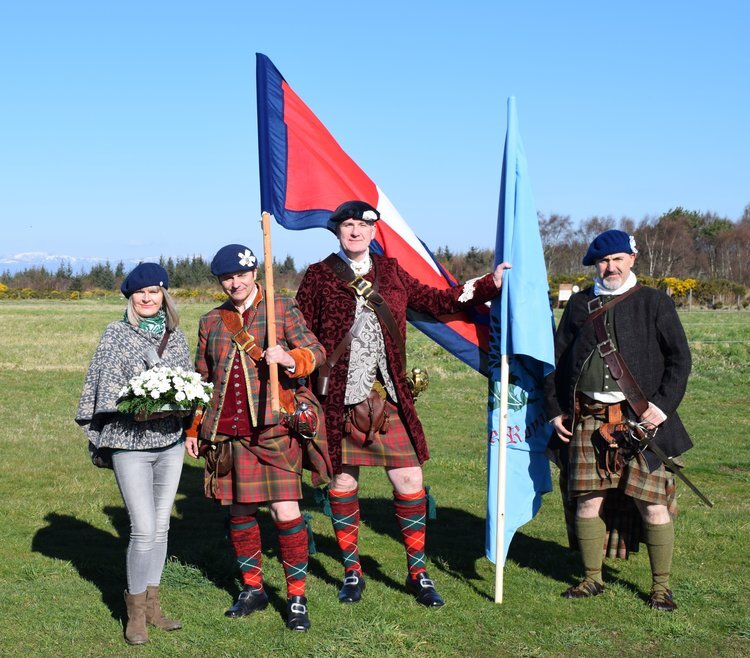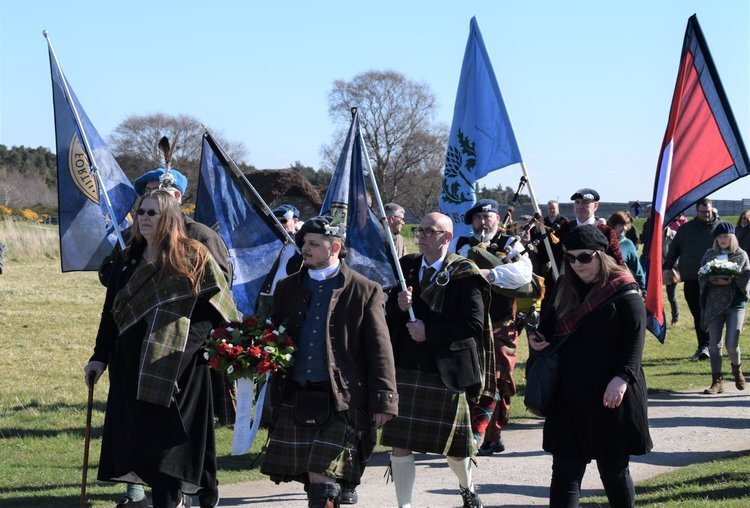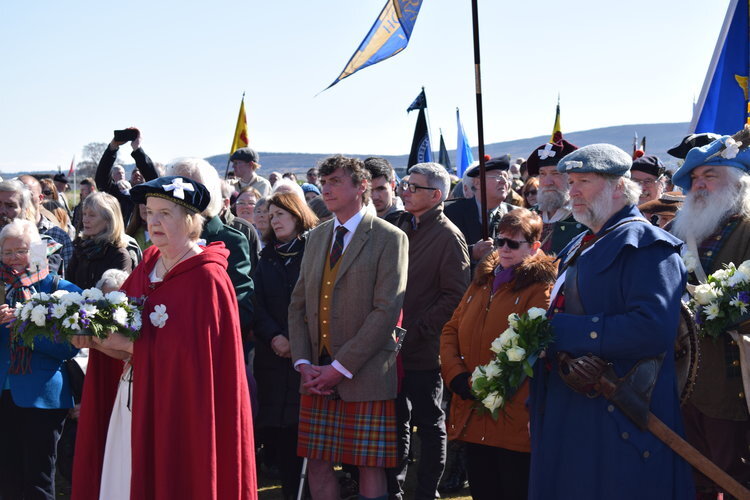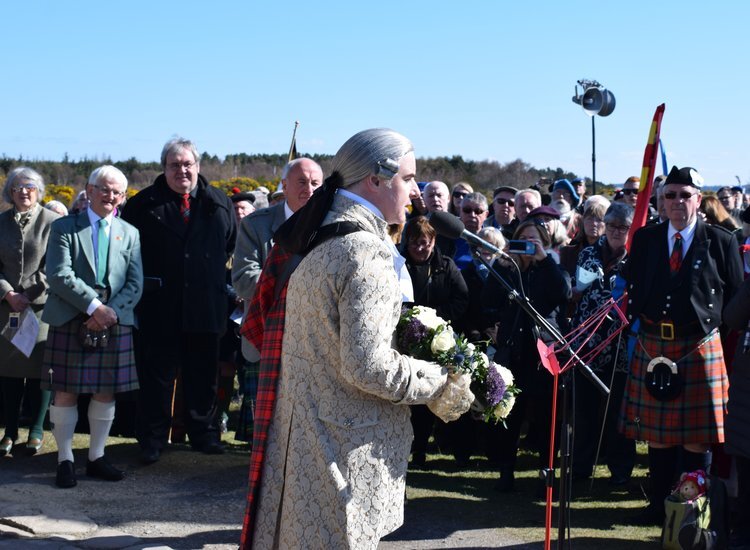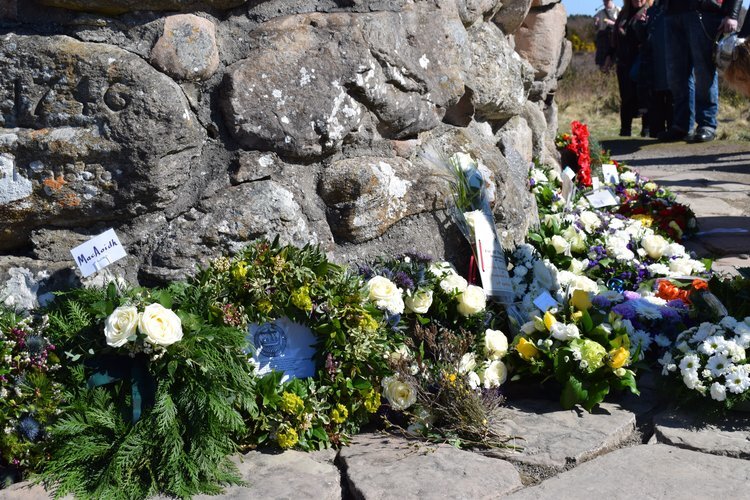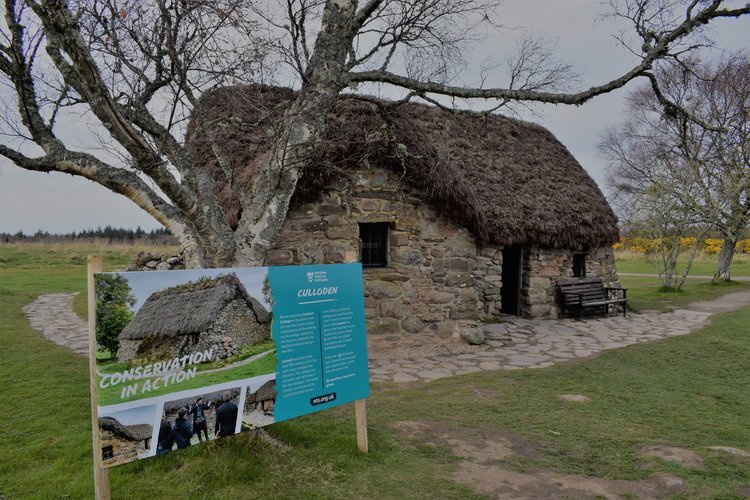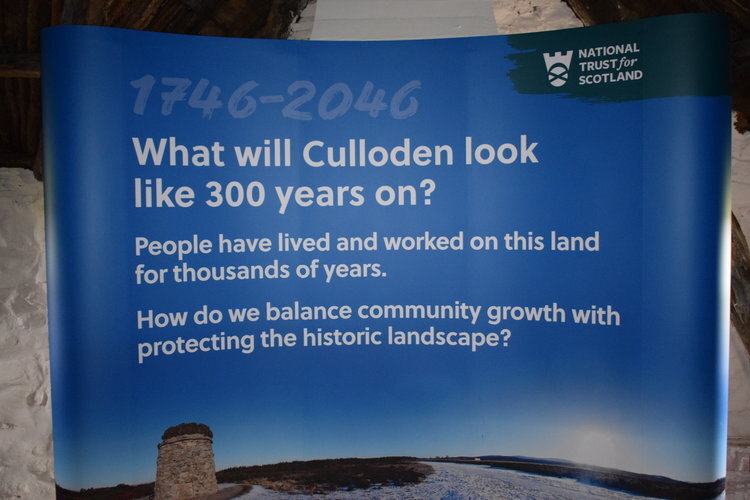Address by Donald Martin Chieftain 2019-20, Gaelic Society of Inverness
Madainn mhath dhuibh, a chàirdean, agus fàilte oirbh còmhla rinn gu làrach Blàr Chùil Lodair air an latha thlachdmhor, àlainn seo. Tha fios agam gu bheil sibh air tighinn bho gach ceàrn dhan t-saoghail agus taing dhuibh airson a bhith an làthair. Is mise Domhnall Martainn agus ‘s e urram mòr a tha ann dhòmhsa a bhith riochdachadh Comunn Gàidhlig Inbhir Nis nam Cheann-cinnidh airson na bliadhna a tha romhainn. Ged a tha mi air a bhith nam bhall den Chomunn airson faisg air dà fhichead bliadhna, cha tàinig e riamh a-staigh orm gum bithinn san dreuchd urramach seo agus tha mi an dòchas gun giùlan mi mo dhleastanas cho math ri na Cinn-cinnidh a bha romham agus gu sònraichte Murchadh Peutan a tha air a bhith na dheagh Cheann-cinnidh dhuibh airson na bliadhna chaidh seachad. Tha mi airson mo thaing phearsanta a thoirt do Mhurchadh airson an deagh chomhairle agus an stiùiridh a thug e dhomh. Bhrosnaich e mi cho math agus gu bheil mi nis a’ coimhead air adhart gu mòr ri bhith còmhla ribh thairis air a’ bhliadhna seo. Tha mi làn chinnteach gum bi sibh taiceil agus foighidneach rium.
Good morning, friends, and a very warm welcome to you all on this rather pleasant, beautiful day to the famous site of the Culloden Battlefield. My name is Donald Martin and it is a great honour for me to be representing the Gaelic Society of Inverness as Chieftain for the coming year. Although I have been a member of the Society for nearly forty years now, it never occurred to me that I would be given this honour and I hope that I will be able to fulfil my duties as effectively as my predecessors and none more so than my immediate predecessor, Murdo Beaton, who gave me so much encouragement and advice that I am now actually looking forward very much to being with you over the next twelve months. I am sure you will be supportive and patient with me during my tenure.
We are all here today to remember, honour and pay tribute to those who fought and died on this battlefield on that bitter, wet day 273 years on the 16th of April. Our presence here today signifies our commitment to honouring the legacy of those who fought and gave their lives fighting for their cause. For making this possible we thank the Gaelic Society of Inverness for ensuring that this annual Culloden Anniversary Commemoration Service has been held here for the past nine decades. As we stand here in silent remembrance today, we reflect on the horrific carnage which left a total of some 2300 of both Government and Jacobite troops dead of which 2000 were Jacobite losses. These losses were catastrophic but worse was to follow with many hundreds more of innocent civilian casualties after the battle not just here but throughout the Highlands and Islands at the hands of the Duke of Cumberland and his forces.
We remember those who lost their lives on this battlefield and elsewhere throughout the Highlands and Islands as well as their families today. But lest we forget, we also remember the devastating impact of the outcome of Cumberland’s revenge on the Highland way of life through the brutal suppression of our language, culture and heritage. Indeed, when we think of the many obstacles placed in the path of our language and culture since the Jacobite defeat at Culloden nearly three centuries ago, it is remarkable that the way of life we are all here to support today, has survived at all. That should give us all hope for the future.
I am sure that most of you here today have looked into your ancestry to establish a family connection with Culloden. In doing some modest research for my own role here today I was surprised to find an indirect family link with the Jacobite cause. I learned from The Inverness Courier dated 25 March 1846 a reference to the death of a John Martin at the age of 112 years and if I have inherited his genes, I have a few years left! The Courier goes on to record “As a boy of 10, Martin had attended Macleod of Berneray when in hiding after the Battle of Culloden Moor in 1746.” Macleod of Berneray was Donald Macleod better known as The Old Trojan originally from the Macleod’s of Skye, who became the tacksman in Berneray, in the sound of Harris. He came under heavy fire here at Culloden Moor but miraculously survived the carnage. He was forced into hiding for helping The Young Pretender in his escape after Culloden and had John Martin as a look-out for him.
That John Martin was my father’s great. great, great grandfather, born in Islivig, Uig, on the isle of Lewis. So I can claim to have a link with the Battle of Culloden through my father’s side of the family.
But my links do not stop there. I have a further connection on my grandmother’s side – my father’s mother, who was a Campbell from Scalpay. The Young Pretender on the run after his heavy defeat at Culloden and with a £30,000 price on his head, landed at Eilean Glas Scalpay having been blown off course by a storm while on his way from Skye to Eriskay. The Prince stayed on Scalpay for four days with the tacksman Donald Campbell, before making his way to Arnish near Stornoway. Donald Campbell’s house which was for a time, the Free Church Manse, had a plaque placed above the front doorway recording the fact that the Prince had stayed there, in hiding, for four nights after Culloden.
Although the house still exists, sadly, the plaque is no longer visible. Apparently, some decades ago some over-enthusiastic contractor covered the plaque with concrete when the house was being renovated. He must have been a Government supporter! The invisible plaque has resulted in the loss of an important element of tangible cultural heritage, linking the island of Scalpay to Prince Charles Edward Stuart travels. Donald Campbell happened to be a distant relative of my paternal grandmother.
The Western Isles of course played an important role in the Prince’s journey both to and from the Battle of Culloden in the months leading to and following the battle. One of the cultural tourism trails that the visitor to the islands can follow today is the Bonnie Prince Charlie trail which takes you to Eriskay where the Prince landed at Coilleag a Phrionnsa in July 1745, just a few hundred yards from where the famous SS Politican sank in 1941, with its valuable cargo of whisky. One wonders when the Young Pretender would have reached Culloden Moor had the Politican sank while the Prince was on Eriskay. The trail takes you to places visited by the Prince in South Uist, and Benbecula in the months leading up to the Battle. Followng the battle, the Prince’s trail to Uist, Harris and Lewis is marked by some commemorative cairns recently constructed by private donation.
These places are well worth a visit after your experience of the excellent facilities at the Culloden Centre here which is so impressively displayed and interpreted in both Gaelic and English. I congratulate The National Trust for Scotland, its funders and supporters in maintaining this impressive world heritage centre on our behalf and extend our further congratulations to them on having recently secured museum accreditation status for the Battlefield Centre. I believe that this status is crucial to protect this atmospheric landscape of Culloden for future generations.
You will all be aware of the current public consultation which the Trust has launched to seek the public’s views on what would be acceptable and appropriate development for the area and I would urge you to support this initiative by giving your views online. In view of the recent controversy regarding a planning decision for housing development virtually on the boundary of this special site of the nation’s cultural heritage, which contains the remains of the thousands who fought and died at Culloden, we do need to ensure that everything possible is done to protect this famous war grave landscape. It is now time for us all – individuals and organisations - to support the National Trust and the Gaelic Society of Inverness in their endeavours to protect this iconic site for future generations and have it designated as a UNESCO World Heritage Site joining such other iconic sites in Scotland as St Kilda and the Neolithic sites in Orkney.
2019 is designated as UNESCO ‘s Year of Indigenous Languages and this gives us the opportunity to raise awareness of our own Gaelic language and culture at international level.
In spite of the considerable progress made in Gaelic education, broadcasting, the arts, government legislation and public agencies support over the past four decades – Gaelic is listed as one of the 2680 endangered minority languages. Recent calls have been made by An Comunn Gàidhealach, Kate Forbes MSP and others to seek Government support to apply for World Heritage Status for the language and I would therefore ask all individuals and organisations with an interest in the preservation of the language to support the campaign for UNESCO status for our language and culture.
Tha e mar dhleastanas oirnne uile aig a bheil ùidh nar cànan, cultar ‘s ceòl an dìleab phrìseil a thug ar sinnsrean dhuinn a dhìon le bhith ga cleachdadh agus a bhith ga brosnachadh aig a h-uile cothrom. Mar a sgrìobh bàrd Chinn Tìre, Donnchadh Mac Ille Ruaidh:-
A Chlanna nan Gàidheal gabhaidh earal san àm
Bithibh dìleas d ur dùthaich, d’ ur canain ’s d’ ur dream
O glèidhibh an dìleab a thugadh dhuibh slàn
Is deagh-chliù ur n-athraichean leanaibh a ghnàth.
Tapaidh leibh, a chàirdean ,agus tha mi an dòchas gun còrd an còrr dhan latha shònraichte seo ribh agus turas math dhuibh air ais dhachaigh. Thank you friends and I hope you enjoy the rest of this very special day and a safe journey home. We look forward to welcoming you all back here for the 2020 Commemoration Service next year. Mòran taing.
Bàs a’ Chòirneil, Teàrlach Friseal, aig Cùil Lodair /
The death of Colonel Charles Fraser at Culloden
A poem by Gaelic Society Bard, Maoilios Caimbeul, read at the 2019 Service
Madainn mhath. Tha mi a’ dol a leughadh earrainn no dhà a sgrìobh mi mu rud a thachair air latha Blàr Chùil Lodair ach an toiseach beagan fiosrachaidh agus dà aithris air na thachair.
I’m going to read some verses I’ve written about something that happened on the day of the battle of Culloden. Colonel Charles Fraser of Inverallochy was the 20-year-old leader of the Frasers at Culloden. He survived the battle but was summarily killed as he lay wounded. There are two versions of the story.
This is John Prebble’s account:
He (i.e. General Hawley, nicknamed ‘The Hangman’) rode by the ground in the middle of the field where the Frasers lay thickly, among them their commander, young Charles Fraser of Inverallochy. He was still alive and stared up from the blood at Hawley’s face. The General turned to one of his staff, who is thought to have been James Wolfe, and told him to pistol the rebel dog. The officer refused, offering his commission instead, and Hawley found a soldier who killed Inverallochy without scruple. [Culloden, p116]
And this is Arthur Herman’s description:
When riding across the battlefield, he (i.e. Cumberland, nicknamed ‘The Butcher’) came upon the twenty-year-old colonel of the Fraser regiment, Charles Fraser of Inverallochy, standing wounded and bloody in front of him. Cumberland asked him to whom he belonged. “To the Prince,” Fraser replied. Furious, Cumberland turned to an officer, Major James Wolfe, and ordered him to shoot the boy on the spot ... Now, to his everlasting credit, Wolfe refused to obey the order, and offered to resign his commission. Instead, Cumberland gave a signal to a passing soldier, who raised his musket and shot Fraser through the head. [How the Scots Invented the Modern World, p153-154
Bàs a’ Chòirneil, Teàrlach Friseal, aig Cùil Lodair The death of Colonel Charles Fraser at Culloden
A Theàrlaich Fhrisealaich, à Inbhir Aileachaidh, Charles Fraser of Inverallochy,
An e An Crochadair a fhuair thu Was it ‘The Hangman’ who found you
Air an latha chruaidh ud air blàr Chùil Lodair, That grim day on Culloden field,
No an e am Bùidsear a dh’fhàg fuar thu? Or was it ‘The Butcher’ who left you cold?
Am blàr seachad, tiùrr cuirp do chàirdean The battle over, your kinsmen’s bodies
Timcheall ort, thusa nad laighe air do leòn, Heaped around you, and you are lying wounded,
Fichead bliadhna a dh’aois, is mòr do chòir Twenty years of age, it was your right
Gum biodh riaghailtean cogaidh gad dhìon. For the rules of war to protect you.
Canaidh cuid gur e an Diùc a chunnaic thu, Some say it was the Duke who saw you
’S am blàr seachad, nad sheasamh ’s cleòca fala ort, After the battle, in a veil of your blood,
’S a thuirt ri Wolfe do spadadh, ach dhiùlt esan; He told Wolfe to dispatch you, but he refused;
’S dh’àithn e an uair sin do shaighdear do mhurt. And then he ordered a soldier to murder you.
Oir b’ e murt a bh’ ann, e cur peilear nad cheann. For it was murder, a bullet in your head.
B’ e Hawley, An Crochadair, a bh’ ann canaidh cuid Some say it was Hawley ‘The Hangman’s’
A rinn an gnìomh suarach, ach ars bith cò Evil deed, but whoever it was
Bha e brùideil, bha e ceàrr, bha e grod. It was brutal, wrong and rotten.

